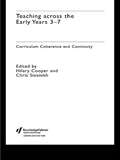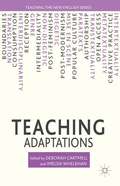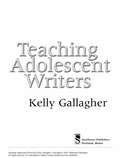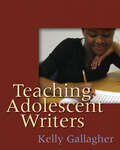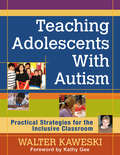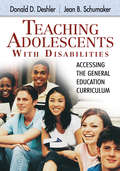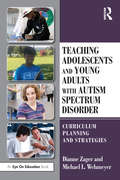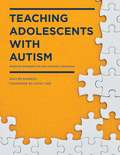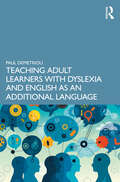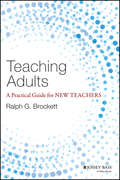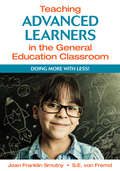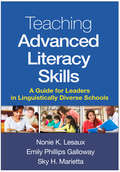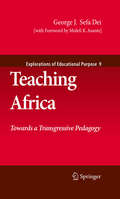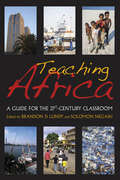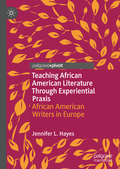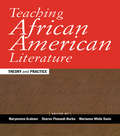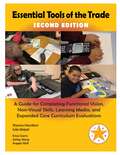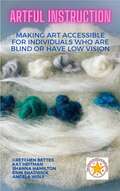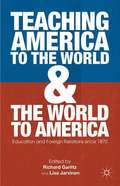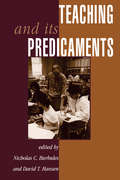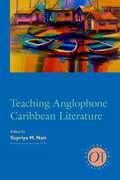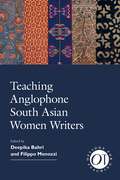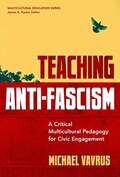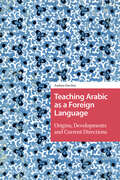- Table View
- List View
Teaching Across the Early Years 3-7: Curriculum Coherence and Continuity
by Hilary Cooper Chris SixsmithThis practical and accessible book explores ways of developing continuity and coherence in children's learning from three to seven years old. It is based around three case studies in which tutors on Initial Teacher Training courses worked with early years practitioners in three different pre-school settings, each linked to a primary school. The book describes how they successfully managed to plan and teach integrated themes across the age-range in the context of the requirements of the Foundation Stage and the National Curriculum.Each case study has a different focus:* science, design and technology*' the arts' - including an ICT strand* 'the humanities' - including a physical education strandEnglish and mathematics dimensions run through each theme.The book is alive with discussion of children's art, language, drama and music, captured as field notes, writing, drawing, and as video tape. Each chapter concludes with suggestions of ways in which readers can develop the ideas in their own contexts.This book will be invaluable reading for students on Early Years courses, Early Years practitioners, and tutors and mentors in early childhood education.
Teaching Adaptations
by Deborah Cartmell Imelda WhelehanTeaching Adaptations addresses the challenges and appeal of teaching popular fiction and culture, video games and new media content, which serve to enrich the curriculum, as well as exploit the changing methods by which English students read and consume literary and screen texts.
Teaching Adolescent Writers
by Kelly GallagherIn an increasingly demanding world of literacy, it has become critical that students know how to write effectively. From the requirements of standardized tests to those of the wired workplace, the ability to write well, once a luxury, has become a necessity. Many students are leaving school without the necessary writing practice and skills needed to compete in a complex and fast-moving Information Age. Unless we teach them how to run with it, they are in danger of being run over by a stampede—a literacy stampede. In Teaching Adolescent Writers, Kelly Gallagher, author of Reading Reasons and Deeper Reading, shows how students can be taught to write effectively. Kelly shares a number of classroom-tested strategies that enable teachers to: - understand the importance of teaching writing; - motivate young writers; - see the importance modeling plays in building young writers (modeling from both the teacher and from real-world text); - understand how providing choice elevates adolescent writing (and how to allow for choice within a rigorous curriculum); - help students recognize the importance of purpose and audience; - assess essays in ways that drive better writing performance. Infused with humor and illuminating anecdotes, Kelly draws on his classroom experiences and work as co-director of a regional writing project to offer teachers both practical ways to incorporate writing instruction into their day and compelling reasons to do so.
Teaching Adolescent Writers
by Kelly GallagherIn an increasingly demanding world of literacy, it has become critical that students know how to write effectively. From the requirements of standardized tests to those of the wired workplace, the ability to write well, once a luxury, has become a necessity. Many students are leaving school without the necessary writing practice and skills needed to compete in a complex and fast-moving Information Age. Unless we teach them how to run with it, they are in danger of being run over by a stampede—a literacy stampede. InTeaching Adolescent Writers , Kelly Gallagher shows how students can be taught to write effectively. Gallagher shares a number of classroom-tested strategies that enable teachers to: Understand the importance of teaching writing and how to motivate young writers Show how modeling from both the teacher and real-world texts builds young writers Provide choice of what to write, which helps elevate adolescent writing, and how to fit it into a rigorous curriculum Help students recognize the importance of purpose and audience Assess essays in ways that drive better writing performance. Infused with humor and illuminating anecdotes, Gallagher draws on his classroom experiences and work as co-director of a regional writing project to offer teachers both practical ways to incorporate writing instruction into their day and compelling reasons to do so.
Teaching Adolescents With Autism: Practical Strategies for the Inclusive Classroom
by Walter G. KaweskiReaching teens with autism requires knowledge and heart Award-winning educator Walter Kaweski offers secondary teachers practical strategies and heartfelt insights based on his extensive experience as an inclusion coordinator and father of a son with Asperger syndrome. Students with special needs often require extra support as they adjust to adolescence. This book offers hundreds of valuable ideas to help teachers: Understand autism Solve adolescent behavior challenges Help students adjust to social situations Implement academic and behavioral interventions This unique resource takes the mystery out of autism and inspires teachers to appreciate the individuality of each student.
Teaching Adolescents With Disabilities: Accessing the General Education Curriculum
by Don Deshler Jean SchumakerAligned with the Individuals with Disabilities Education Act and No Child Left Behind Act requirements, this comprehensive guide empowers teachers and administrators with research-validated practices and interventions that can close the general-curriculum performance gap and break down the barriers to academic success for middle and high school students with disabilities. This insightful resource features: Practical planning advice, teaching practices, and learning strategies for inclusive classrooms Methods for designing instructional materials Tips for effectively leveraging technology Strategies for transition beyond high school Real-life examples and illustrations
Teaching Adolescents and Young Adults with Autism Spectrum Disorder: Curriculum Planning and Strategies
by Michael L. Wehmeyer Dianne ZagerTeaching Adolescents and Young Adults with Autism Spectrum Disorder supports teachers in preparing secondary students with autism spectrum disorder (ASD) to succeed in school, work and beyond. Focused on enabling students to successfully pursue further education and meaningful career paths, chapters incorporate person-centered, student-directed planning into instructional programming throughout the text. Featuring helpful vignettes to demonstrate concepts in action, curriculum areas address community living skills, academics, social communication and interaction, and career preparation. Grounded in current research and Universal Design for Learning practices, this guide is an essential resource for educators, therapists, and anyone seeking to create fluid, adaptable programs for students with autism spectrum disorders.
Teaching Adolescents with Autism: Practical Strategies for the Inclusive Classroom
by Walter KaweskiAward-winning educator Walter Kaweski offers secondary teachers practical strategies and heartfelt insights based on his extensive experience as an autism specialist, inclusion coordinator, and father of a son with Asperger syndrome. Students with special needs often require extra support as they adjust to middle and high school and the changes that accompany adolescence. Without support, this time can be overwhelming. Teaching Adolescents with Autism offers hundreds of valuable ideas to help teachers: Understand the causes and manifestations of autism Solve adolescent behavior challenges Support students with diverse needs Implement academic and behavioral interventions Help students adjust to social situations Understand special education policyEach chapter offers numerous personal stories that illustrate and reinforce strategies in a tangible way. Important concepts are augmented with bulleted lists, tables, figures, photographs, and cartoons drawn by a student with autism. This unique book takes the mystery out of teaching adolescents with autism and inspires teachers to appreciate the individuality of each student.
Teaching Adult Learners with Dyslexia and English as an Additional Language: Practical Tips to Support Best Practice
by Paul DemetriouPacked full of practical tips to use in the classroom, case studies to provide theoretical grounding and ideas to improve inclusion, Teaching Adult Learners with Dyslexia and English as an Additional Language covers all the key areas necessary to ensure inclusive and effective teaching practice in higher and further education settings. This book provides a coherent framework for those looking to develop their knowledge and skills in this challenging area and explores key areas such as: teaching and learning strategies, differentiation, assessment, feedback and supporting students using technology. It provides a unique insight into how to develop a thorough understanding of the needs of learners and the principles and practices of how to meet those needs within a classroom setting. This is an essential introductory book for anyone working or training to work in either Further or Higher Education and who wishes to develop knowledge and skills in the challenging area of supporting and teaching adult EAL learners with learning differences.
Teaching Adults
by Ralph G. BrockettA highly practical guide for new instructors teaching in any settingRegardless of the context, teaching is a tall task--and for those teaching adults, unique challenges await. Teaching Adults: A Practical Guide for New Teachers is chock-full of ideas that can be read quickly and implemented immediately in formal and informal settings, in classrooms and workplaces; in short, wherever adults are learning.Written with straightforward language that eschews jargon, yet grounded in theory, research, and practice in adult education, the book will benefit readers who have not previously been exposed to these ideas as well as more experienced teachers who seek new ways to reach adult learners. The book will serve as a resource to revisit from time to time as readers face new challenges and questions in teaching adults.Readers will delve into to a variety of topics, including:A general teaching framework, including the author's four keys to effective teachingAn in-depth exploration of the primary components of effective teachingAn examination of the unique challenges involved with teaching adults, including how to best create a positive learning environment, overcoming resistance to learning, motivation techniques, and dealing with difficult or disruptive learnersThe book elucidates the techniques required to connect with adult learners and provide instruction that is specifically tailored to the unique learning needs of these students.
Teaching Advanced Learners in the General Education Classroom: Doing More With Less!
by Joan F. Smutny Sarah E. von FremdLow-stress tips for challenging high-ability learners Many teachers ask: “What do I do for students who finish their work before everyone else?” If you would like to do more for gifted students and need simple strategies that you can use tomorrow, this book is for you. Inside are helpful methods for challenging students who need more than the regular curriculum can provide. The authors provide practical tools, including: Tips for using existing resources and potential A progression from simpler to more complex adjustments for advanced learners Specific lessons for language arts, math, science, social studies, and the arts
Teaching Advanced Literacy Skills: A Guide for Leaders in Linguistically Diverse Schools
by Sky H. Marietta Emily Phillips Galloway PhD Nonie K. LesauxIn our knowledge-based society, K-8 students need to develop increasingly sophisticated skills to read, write, and speak for a wide variety of purposes and audiences. Including an extended case example from a linguistically diverse school, this book guides school leaders to design and implement advanced literacy instruction through four key shifts: strengthening the instructional core, giving data a central role, using a shared curriculum, and providing supportive and tailored professional development. Reproducible forms and templates facilitate planning and implementation of schoolwide initiatives. Purchasers get access to a Web page where they can download and print the reproducible materials in a convenient 8 1/2" x 11" size.
Teaching Africa
by George J. Sefa DeiWritten from the perspective of a knowledge base and educational practice that are both African-centred, this volume uses a discursive pedagogy that is anti-colonial in origin. It theorizes colonial - and re-colonial - relations and the implications of imperial structures on knowledge production and use; the understanding of indigenousness; and the pursuit of agency, resistance and subjective politics. Using a refined definition of colonial, less as 'foreign' or 'alien' but more 'imposed and dominating', the author shows us how colonialism is domesticated and how those who have been oppressed by dominant/hegemonic discourses may find it difficult to step out of them, let alone challenge or resist them. The book is a call for a critical interrogation of dominant knowledge about Africa in order to help the contemporary learner come to grips with the challenges and possibilities of knowing about the African world and the African human condition. The author's anti-colonial discursive platform addresses distorted Eurocentric views of Africa, raises ontological and epistemological questions about teaching methods and methodologies relating to Africa, and highlights knowledge indigenous to Africa. At the same time, it shows what the rest of the world can learn from this knowledge.
Teaching Africa: A Guide For The 21st-century Classroom
by Brandon D. Lundy Solomon NegashTeaching Africa introduces innovative strategies for teaching about Africa. The contributors address misperceptions about Africa and Africans, incorporate the latest technologies of teaching and learning, and give practical advice for creating successful lesson plans, classroom activities, and study abroad programs. Teachers in the humanities, sciences, and social sciences will find helpful hints and tips on how to bridge the knowledge gap and motivate understanding of Africa in a globalizing world.
Teaching African American Literature Through Experiential Praxis: African American Writers in Europe
by Jennifer L. HayesThis book focuses on teaching African American literature through experiential praxis. Specifically, the book presents several canonical African American literature authors in a study abroad context. The book chapters consider the historical implications of travel within the African American literature tradition including slave narratives, migration narratives, and expatriate narratives. The book foregrounds this tradition and includes activities, rhetorical prompts, and thematic discussion that support instruction.
Teaching African American Literature: Theory and Practice (Transforming Teaching Ser.)
by Maryemma Graham Sharon Pineault-Burke Marianna White DavisThis book is written by teachers interested in bringing African American literature into the classroom. Documented here is the learning process that these educators experienced themselves as they read and discussed the stories & pedagogical.
Teaching Age-Appropriate Purposeful Skills Part 3 Appendices
by Debra Sewell Rona Pogrund Heidi Anderson Lisa Calaci [et al.]An Orientation & Mobility Curriculum for Students With Visual Impairments 3rd Edition
Teaching Age-Appropriate Purposeful Skills: Comprehensive Initial and Ongoing Evaluation
by Debra Sewell Rona Pogrund Heidi Anderson Lisa CalaciA comprehensive evaluation tool is designed to be used by trained orientation and mobility specialists to identify a student's current functioning level in all areas of orientation and mobility in order to determine student needs for programming
Teaching Age-Appropriate Purposeful Skills: Street Crossings for Travelers Who Are Visually Impaired
by Linda Myers Wendy SchiffersIt helps travelers lower the inherent risk in crossing streets. Travelers who learn and apply this information will be safer and better able to travel independently in familiar and unfamiliar areas with less need for mobility instruction in the future.
Teaching America to the World and the World to America
by Richard Garlitz Lisa JarvinenA fresh analysis of the study of American foreign relations history, this book shows the ways in which international education has shaped the US relationship with the world.
Teaching And Its Predicaments
by Nicholas BurbulesTeaching is a complex and challenging endeavour. Teachers are continually faced with difficult choices in which competing values are set in tension with one another. The interests of all students, and of other groups and constituencies, can rarely be served at the same time. Different educational goals, each desirable in and of itself, often place
Teaching Anglophone Caribbean Literature (Options for Teaching #34)
by Grant Farred Nicole N. Aljoe Giselle Liza Anatol Albert Braz Elaine Savory John C. Hawley Elizabeth Way Alisa K. Braithwaite Jennifer P. NesbittThis volume in the Options for Teaching series recognizes that the most challenging aspect of introducing students to anglophone Caribbean literature--the sheer variety of intellectual and artistic traditions in Western and non-Western cultures that relate to it--also offers the greatest opportunities to teachers. Courses on anglophone literature in the Caribbean can consider the region's specific histories and contexts even as they explore common issues: the legacies of slavery, colonialism, and colonial education; nationalism; exile and migration; identity and hybridity; class and racial conflict; gender and sexuality; religion and ritual. While considering how the availability of materials shapes syllabi, this volume recommends print, digital, and visual resources for teaching.The essays examine a host of topics, including the following: the development of multiethnic populations in the Caribbean and the role of various creole languages in the literatureoral art forms, such as dub poetry and reggae musicthe influence of anglophone literature in the Caribbean on literary movements outside it, such as the Harlem Renaissance and black British writingCarnivalreligious rituals and beliefsspecific genres such as slave narratives and autobiographyfilm and dramathe economics of rumMany essays list resources for further reading, and the volume concludes with a section of additional teaching resources.
Teaching Anglophone South Asian Women Writers (Options for Teaching #52)
by Edited by Deepika Bahri and Filippo MenozziGlobal and cosmopolitan since the late nineteenth century, anglophone South Asian women's writing has flourished in many genres and locations, encompassing diverse works linked by issues of language, geography, history, culture, gender, and literary tradition. Whether writing in the homeland or in the diaspora, authors offer representations of social struggle and inequality while articulating possibilities for resistance.In this volume experienced instructors attend to the style and aesthetics of the texts as well as provide necessary background for students. Essays address historical and political contexts, including colonialism, partition, migration, ecological concerns, and evolving gender roles, and consider both traditional and contemporary genres such as graphic novels, chick lit, and Instapoetry. Presenting ideas for courses in Asian studies, women's studies, postcolonial literature, and world literature, this book asks broadly what it means to study anglophone South Asian women's writing in the United States, in Asia, and around the world.
Teaching Anti-fascism: A Critical Multicultural Pedagogy For Civic Engagement (Multicultural Education Ser.)
by James A. Banks Michael VavrusThis timely book examines how fascist ideology has taken hold among certain segments of American society and how this can be addressed in curriculum and instruction. Vavrus presents middle, secondary, and college educators and their students with a conceptual framework for enacting a critical multicultural pedagogy by analyzing discriminatory discourse and recommending civic anti-fascist steps people can take right now. For teacher education programs and policymakers, anti-fascist civic assessment rubrics are provided. To help clarify contemporary debates over what can be taught in public schools, an advance organizer highlights contested and misunderstood terminology. Featuring historical and contemporary patterns of fascist politics, this accessible text is organized in four parts: “Good Trouble,” Unpacking Ideological Orientations, Indicators of Colonial Proto-Fascism and U.S. Fascist Politics, and An Anti-Fascist “Reading the World.” Readers will come away with a deeper knowledge base that marshalls a century of anti-fascist actions in response to contemporary acts of racism, anti-Semitism, Islamophobia, gender and sexuality discrimination, bias against Latinx and migrant populations, and other actions that undermine our democracy and harm marginalized students and their families and communities. Book Features: A groundbreaking framework for incorporating anti-fascist pedagogical concepts into multicultural education Descriptions of common characteristics of historical fascism, far-right extremism, and anti-fascism. Anti-fascist assessment rubrics for teacher educators. Guidance to assist classroom teachers in contextualizing current anti-democracy events. Recommended and annotated anti-fascist background readings informed by critical, theoretical, and intersectional perspectives.
Teaching Arabic as a Foreign Language: Origins, Developments and Current Directions
by Andrea FacchinTeaching Arabic as a Foreign Language concentrates on the origins, developments and current directions of the discipline Teaching Arabic as a Foreign Language (TAFL) within the Arab world and partially outside of it during the last 60 years, namely between 1958 and 2018. Considered in this volume are the most influential scholars, authors, educators and those significant works that have contributed to the development of the discipline. In addition, special attention is paid to the TAFL institutes, regarded as epicenters of TAFL activities and important meetings, that allow scholars to gather around the same table and discuss approaches, trends and methods used in the field. All of these aspects converge in one comprehensive study which is enriched by a narration of the main sociopolitical changes that have affected the Middle East in latter-day history.
